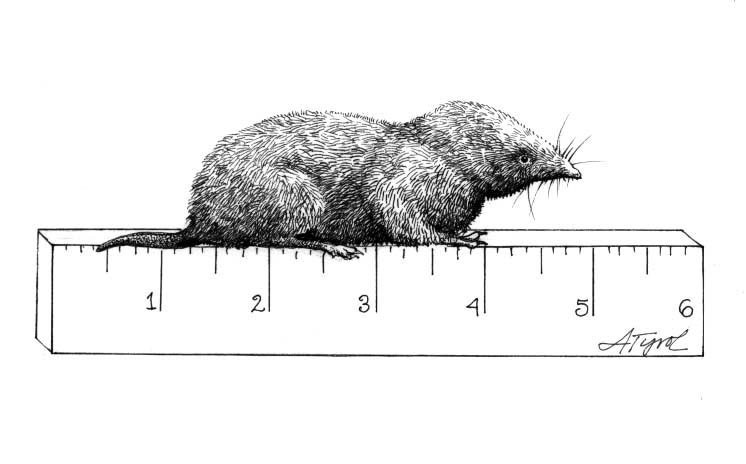
On occasion I’ve asked friends what they knew about shrews, and almost without exception the question simply puzzled them. Not only had they never seen any such creature, they hadn’t known any such creature existed. (One exception said: “I know all about shrews; I’ve been married to a couple of ‘em.”)
Many people, of course, do not wish to make the acquaintance of any mammal smaller than a chipmunk, but even those eager to know the local fauna are likely to write off any rustle in the leaves or brief glimpse of something small and furry as a mouse or vole. Which it may be. It may also be our most common, and largest, native shrew, the northern short-tailed (Blarina brevicauda).
In the hand, no one would mistake this animal for a mouse. Rather than long and lean, long-tailed, big-eyed and -eared, a short-tail is a dumpy velvety beanbag with no visible ears and tiny bead-like eyes often hidden in the fur. And if you bend a shrew’s snout up to expose the mouth, you will find not the mouse’s vegetarian teeth – the broad, flattened incisors (the buck teeth of cartoon gophers and rabbits) for shearing – but rather a generalist carnivore’s dental arrangement: round, pointed, forward-projected incisors (for seizing, biting), unicuspids (for grasping, tearing), and molars (for crushing, chewing).
Shrews are not, in short, rodents at all, but rather insectivores, allies of the moles. They even do a bit of tunneling (in the hand you will notice that the nostrils open to the sides of the snout, to prevent plugging), but mostly they forage in, under, and above the “carpet” – leaf litter, vegetable matter, moss, snow – that covers the ground. While mice and voles are always in a panic, always fleeing, shrews are neither programmed nor equipped (they have poor eyesight and smell) to be afraid; which means that if you have the patience to take a stand (or sit) in the woods, sooner or later you will be able to watch a brevicauda forage right in front of your nose.
It will move in starts and stops, disappearing into leaf litter and reappearing, heading now in this direction, now in that, moving in a hustling trot, then pausing to raise the head and twitch the snout, investigating along mouse runways and under stones and along logs. You might even be lucky enough to see your shrew make a catch and devour an earthworm or beetle, a centipede or spider, a sow bug or snail, a bit of carrion or dropped sandwich.
Surprisingly, shrews will also tackle small vertebrates. Teddy Roosevelt put a native mouse into a cage occupied by a short-tailed shrew to see what would happen. The “blood-thirsty little Shrew” attacked the larger mouse, which “squeaked piteously.” After a brief fight, the shrew dispatched the mouse and proceeded to feast. The incident shocked the architect of San Juan Hill.
Presumably Roosevelt would have been more horrified had he known that, unique among mammals, several shrews, including our common short-tail, secrete from submaxillary glands a neurotoxic poison, which, although not a particularly efficient weapon (they lack an injection mechanism), presumably aids these carnivores when attacking large and active prey. The notion that a shrew’s bite was venomous, long dismissed by sober science, was a staple of European folk legend, which is why a “shrewish woman” was once a genuinely malevolent figure rather than, as in my friend’s usage, merely a tiresome scold.
Shrews are often described as “savage” and “voracious.” But warm-bloodedness and carnivory are an expensive combination for a small animal, which must metabolize rapidly to compensate for high rates of heat and water loss. (Our diminutive masked shrew maintains heartbeat and respiration rates of 800 per minute; small wonder that shrews are prone to heart attacks.) Fueling that metabolism means hunting for four or five hours, sleeping for two or three, then doing it all over again, night and day, spring, summer, fall, and winter. And mostly alone, as shrews can’t afford to waste time and energy socializing.
It is a cliché of the popular nature literature that few wild animals die of old age. Shrews do, by the millions, every fall, when fresh carcasses mysteriously appear in woods and marshes, along fencerows and back roads and in backyards. Within the package of speeded-up life processes that is every shrew’s birthright is the aging process; and, as autumn rolls around, short-tails in their second year are simply running out of gas.
Individuals that have avoided or survived predation and accidents and disease and starvation for two summers have lived a full (if parochial) life, and the massive fall die-off of adults leaves their last, maturing offspring free to scavenge for a soon-to-be radically diminished food supply without competition from their forgotten parents’ generation.


Discussion *